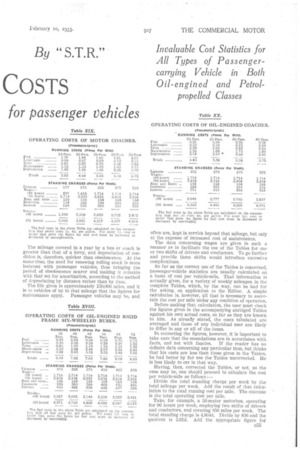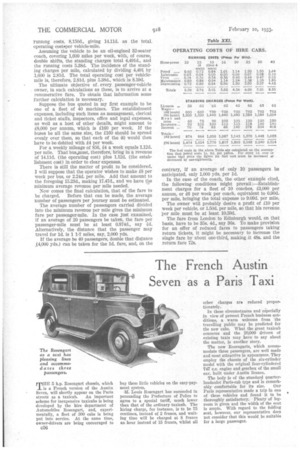How TO
Page 104

Page 105

Page 106

If you've noticed an error in this article please click here to report it so we can fix it.
CALCULATE COSTS
for passenger vehicles
TIME flies, and it needs must, to keep pace with the advance of passenger-vehicle design and use -or so it seems, sometimes. Not so very long ago-or so I should have said before 1 tried to find the article and looked back through 10 years' issues of The Commercial Motor without locating it-an adventurous contributor described how he had travelled from London to Edinburgh by road. He changed from bus to bus and took, if my memory serves me aright, three or four days over the journey. The article was illustrated by photographs of the bus tickets ; it had to be, in proof of good faith.
Nowadays, hundreds of people make the journey each week. They think nothing of it and do it comfortably in 16 hours, with stops for meals.
This alteration has been made possible not only by improvements in the vehicles, chiefly exemplified in the development of the pneumatic tyre, but also in the greater comfort of the coachwork, upholstery and springing. Above all, it has been made commercially practicable by a reduction in operating costs.
This matter of cost has always been more important, generally speaking, in relation to passenger-vehicle operation than with goods transport. The annual mileages of coaches and buses are usually greater, and, whilst increased mileage means less cost per mile, it also magnifies the benefits of quite small and otherwise insignificant economies in running cost.
Per contra, small increases in those seemingly disproportionate costs have an effect on the total outgoings. These circumstances naturally tend to increase the interest and importance of The Commercial Motor Tables of Operating Costs, extracts from which accompany this article.
To those who are unacquainted with them, these figures require a little explanation, first as to their origin, secondly as to their arrangement, and thirdly as to their use.
Users' figures are painstakingly collected and colcff4
lated, corrected to suit current commodity prices, totalled and averaged. The Tables present those averages-results that anyone may achieve. Users should be able to better the figures : if they cannot equal them, they have cause to investigate their methods and search for sources of loss and leakage.
The classification of the items into running costs and standing charges needs little explanation. There may be a query as to the justification for including depreciation amongst the former. There is more justification for including depreciation amongst the running costs, in the case of passenger vehicles, than in connection with goods machines.
The mileage covered in a year by a bus or coach is greater than that of a lorry, and depreciation of condition is, therefore, quicker than obsolescence. At the same time, the need for renewing rolling stock is more insistent with passenger vehicles, thus bringing the period of obsolescence nearer and making it coincide with that set for amortization, according to the method of depreciating by distance rather than by time.
The life given is approximately 150,000 miles, and it is to vehicles of up to that mileage that the figures for maintenance apply. Passenger vehicles may be, and
often are, kept. in servic'e beyond that mileage, but only at Lhe expense of increased cost of maintenance.
The data concerning wages are given in such a manner as to facilitate the use of the Tables for one or two shifts of drivers and conductors. To go further and provide three shifts would introduce excessive complications.
So far as the correct use of the Tables is concerned, passenger-vehicle statistics are usually calculated on a basis of cost per vehicle-mile. That information is actually given, for a variety of weekly mileages, in the complete Tables, which, by the way, can be had for the asking, on application to the Editor. A. simple calculation is, however, all that is necessary to ascertain the cost per mile under any condition of operation.
Before making that calculation, the user must eheck the figures given in the accompanying abridged Tables against his own actual costs, so far as they are known to him. As already stated, the costs tabulated are averaged and those of any individual user are likely to differ hi any or all of the items.
In correcting the figures, however, it is important to take care that the emendations are in accordance with
facts, and not with fancies. If the reader has no definite data concerning any particular item, but thinks that his costs are less than those given in the Tables, he had better by far use the Tables uncorrected. He is less likely to err in that way.
Having, then, corrected the Tables, or not, as the case may be, one should proceed to calculate the cost per vehicle-mile as follows:- Divide the total standing charge per week by the total mileage per week. Add the result of that calculation to the total running cost per mile. The outcome is the total operating cost per mile.
Take, for example, a 56-seater motorbus, operating for 06 hours per week, employing two shifts of drivers and conductors, and covering 856 miles per week. The total standing charge is 4,804d. Divide by 856 and the quotient is 5.61d. Add the appropriate figure for running costs, 8,150d., giving 14.11th as the total, operating eosteper vehicle-mile.
Assuming the vehicle to be an oil-engined 32-seater coach, covering 1,600 miles per week, with, of course, double shifts, the standing charges total 4,491d., and the running costs 5.38d. The incidence of the standing charges per mile, calculated by dividing 4,491 by 1,600 is 2.81d. The total operating cost per vehiclemile is, therefore, 2.81d. plus 5.38d., which is 8.19d.
The ultimate objective of every passenger-vehicle owner, in such calculations as these, is to arrive at a remunerative fare. To obtain that information some further calculation is necessary.
Suppose the bus quoted in my first example to be one of a fleet of 40 machines. The establishment expenses, including such items as management, clerical and ticket staffs, inspectors, office and legal expenses, as well as a host of other details, might amount to £8,000 per annum, which is £160 per week. If the buses be all the same size, the £160 should be spread evenly over them, so that each of the 40 would then have to be debited with £4 per week.
For a weekly mileage of 856, £4 a week equals 4.12d. per mile. That bus.must, therefore, bring in a revenue of 14.11d. (the operating cost) plus 1.12d. (the establishment cost) in order to clear expenses.
There is still the matter of profit to be considered. I will suppose that the operator wishes to make £8 per week per bus, or 2.24d. per mile. Add that amount to the foregoing 15.23d., making 17.47d., and we have the minimum average revenue per mile needed.
Now comes the final calculation, that of the fare to be charged. Before that can be made, the average number of passengers per journey must be estimated.
The average number of passengers carried divided into the minimum revenue per mile gives the minimum fare per passenger-mile. In the case just examined, if an average of 20 passengers be taken, the fare per passenger-mile must be at least 0.874d., say id. Alternatively, the distance that the passenger may travel for id. is 1 1-7 miles, say, 2,000 yds.
If the average be 40 passengers, double that distance ,(4,000 yds.) can be taken for the id. fare, and, On the THE 5 h.p. Rosengart chassis, which is a French version of the Austin Seven, will shortly appear on the Paris
streets as a taxicab. An important scheme for inexpensive taxicabs is being developed by the hire department of Automobiles Rosengart, and, experimentally, a fleet of 300 cabs is being put into service. At the same time, owner-drivers are being encouraged to buy these little vehicles on the easy-payment system.
.31. Louis Rosengart has succeeded in persuading the Prefecture of Police to agree to a special tariff, much lower than that of the ordinary taxicab. The hiring charge, for instance, is to be 75 centimes, instead of 2 francs, and waiting time will be charged at 8 francs an hour instead of 15 francs, whilst all other charges aro reduced propon. tionately. In these circumstances and eipecially in view of present French business conditions, a warm welcome from the travelling public may be predicted for the new cabs. What the great taxicab concerns and the 20,000 drivers of existing taxis may have to say about the matter, is another story.
The new Rosengarts, which accommodate three passengers, are well made and most attractive in appearance. They employ the chassis of the six-cylinder model with the original four-cylindered 747 C.c. engine and gearbox of the small car, built under Austin licence.
The body is of the standard quarterlandaulet Paris-cab type and is remark
ably comfortable for its size. Our Paris representative made a trip in one of these vehicles and found it to be thoroughly satisfactory. Plenty of legroom is given and the width of the seat is ample. With regard to the folding seat, however, our representative does not consider that this would be suitable for a large passenger.




































































































































































